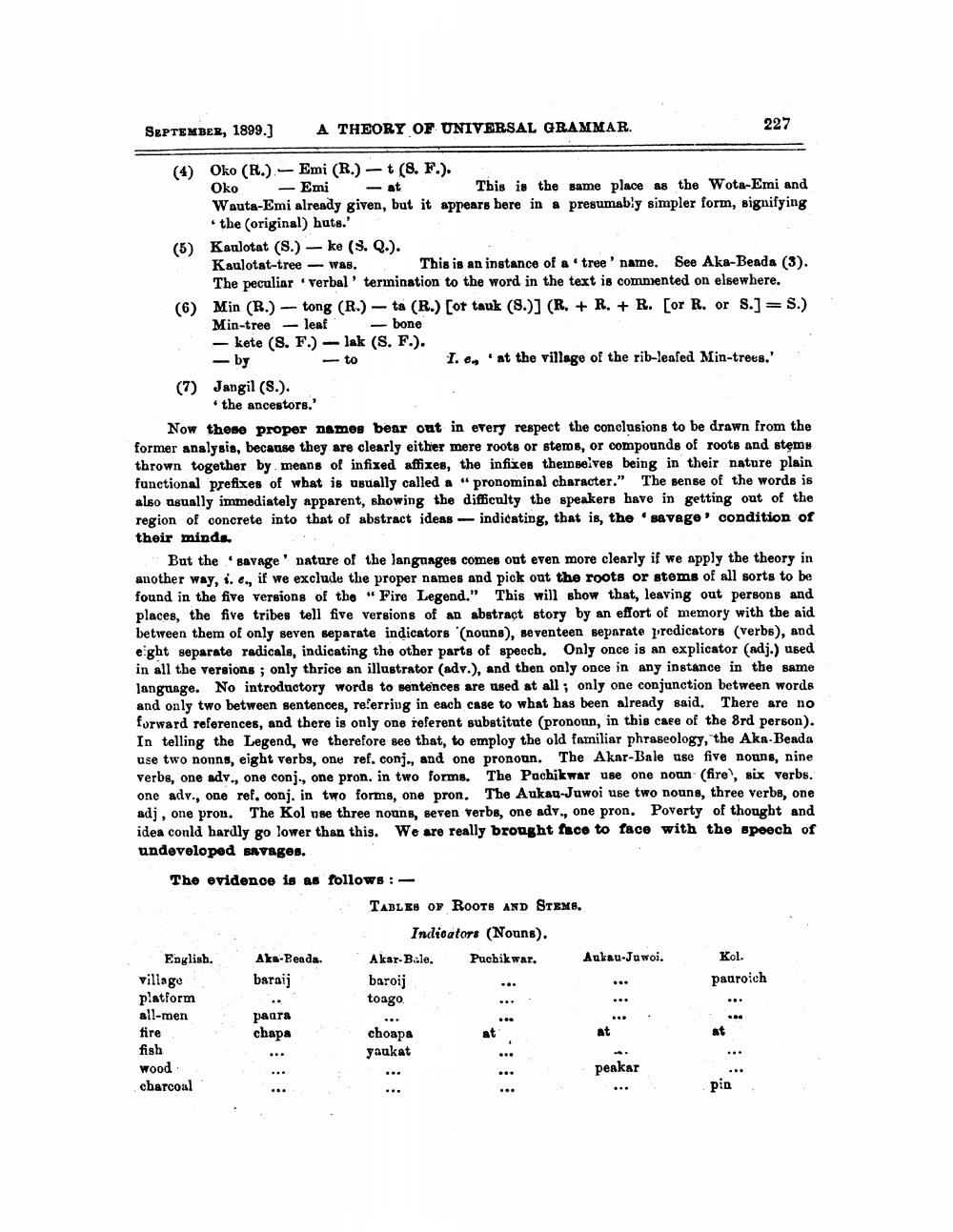________________
SEPTEMBER, 1899.)
A THEORY OF UNIVERSAL GRAMMAR
227
(4) Oko (R.).- Emi (R.) -t (8. F.). Oko - Emi
This is the same place as the Wota-Emi and Wauta-Emi already given, but it appears here in a presumably simpler form, signifying
the (original) huts.' (5) Kaulotat (S.) - ke (s. Q.).
Kaulotat-tree - was. This is an instance of a tree' name. See Aka-Benda (3). The peculiar verbal' termination to the word in the text is commented on elsewhere. Min (R.) - tong (R.) - ta (R.) [ot tauk (S.)] (R. + R. + R. [or R. or S.]=S.) Min-tree - leaf - bone - kete (8. F.) - lak (S. F.). - by
to
I. es at the village of the rib-leafed Min-trees.' (7) Jangil (S.).
the ancestors.' Now these proper damos bear out in every respect the conclusions to be drawn from the former analysis, because they are clearly either mere roots or stems, or compounds of roots and stems thrown together by means of infixed affixes, the infixes themselves being in their nature plain functional prefixes of what is usually called a "pronominal character.” The sense of the words is also usually immediately apparent, showing the difficulty the speakers have in getting out of the region of concrete into that of abstract ideas - indicating, that is, the savage' condition of their mind..
But the savage' nature of the languages comes out even more clearly if we apply the theory in another way, i. e., if we exclude the proper names and pick out the roots or stems of all sorts to be found in the five versions of the "Fire Legend." This will show that, leaving out persons and places, the five tribes tell five versions of an abstract story by an effort of memory with the aid between them of only seven separate indicators (nouns), seventeen separate predicators (verbs), and eight separate radicals, indicating the other parts of speech. Only once is an explicator (adj.) used in all the versions ; only thrice an illustrator (adv.), and then only once in any instance in the same language. No introductory words to sentences are used at all ; only one conjunction between words and only two between sentences, re!errivg in each case to what has been already said. There are no forward references, and there is only one referent substitute (prononn, in this care of the 3rd person). In telling the Legend, we therefore see that, to employ the old familiar phraseology, the Aka-Beada use two nonns, eight verbs, one ref. conj., and one pronoun. The Akar-Bale use five nouns, nine verbs, one adv., one conj., one pron. in two forms. The Pachikwar use one noun (fire, six verbs. one adv., one ref, conj, in two forms, one pron. The Aukau-Juwoi use two nouns, three verbs, one adj, one pron. The Kol use three nouns, seven Verbs, one adv., one pron. Poverty of thought and idea conld hardly go lower than this. We are really brought face to face with the speech of undeveloped savages. The evidence is as follows:
TABLES OF ROOTS AND STEMS.
Indicators (Nouns). English. Aka-Beada. Akar-Bale. Puchikwar. Aukau-Jawoi. baraij baroij
patroich platform
toago all-men
paura chapa
choapa fish
yaukat wood
peakar charcoal
Kol.
village
fire
pin




